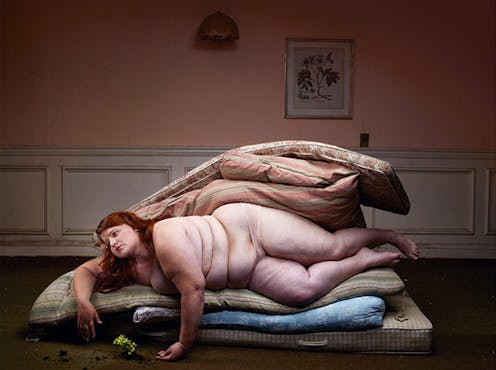Fashion
Why Full On Nudity Is Important To Size Acceptance

When I saw images of Julia Fullerton-Batten's Unadorned project, it took my breath away for a moment. The fine art nudes nudes feature several plus-size, fat bodies in poses and settings with styling that's reminiscent of classical European art. Hearkening back to an era during which fuller figures were more celebrated, immortalized, and captured in art was Fullerton-Batten's intention. "I placed them individually in a scene with appropriate props and asked them to pose in ways that would show off their shape naturally and enhance their beauty," she wrote in her artist statement. "I simulated soft candle — and moonlight to recreate that seen in the old masters’ paintings." The results are literally, at least IMO, breathtaking.
The photographer did this in an attempt to give these bodies the same type of reverence and respect that thinner and generally smaller bodies in our culture are given — both for the models and for their audience. "My models accept that their bodies are as nature intended them to be. They show honesty, both to others and themselves in a world all too often dominated by manipulated beauty," she wrote. The images are at once an important part of the size acceptance movement and like nothing I have ever seen when it comes to body positive photography.
While I know that there are many people in this world who don't agree that nudity can be empowering, but who believe, rather, that female nudity is always "pandering to the male gaze," I heartily disagree, and images like those in this series or Laverne Cox's flawless nude shoot are proof. Being unapologetically visible in spaces where your body is stigmatized is a radical act and I refuse to take that power away from anyone who has experienced it.
Bodies that aren't up to the societal standards of "perfection" or even "acceptability" definitely fall into the category of stigmatized and ridiculed. Plus-size bodies are in that category as a whole, but it seems the larger the body is and the further it strays from the so-called desirable plus-size body shape, the more people resist from looking at it, or do so begrudgingly with disgust. Being nude under this pretense isn't objectification, it is liberation.
Even in the art world, where boundaries are meant to be pushed and anything is supposed to go, it seems like there is a lack of diverse representations of plus-size and fat bodies. I do wish that this series of images showed a wider cast of models more diverse in race, ability, and gender to further flip the script on Western beauty ideals and acceptable gender presentation within the binary for this reason. When these bodies are present in art, it feels like they're often played up for their differences or to sensationalize the bodies pushed to the margins. This is what makes the photo series' simplicity seem so stunning.
As Italian artist Yossi Loloi, who also shoots nude photos of plus-size women pointed out to Marie Southard Ospina: “The more people accuse me of promoting fat, the more I understand that there is more work to be done to remind people that we are beautiful because we are different." He pointed out the hypocrisy of the acceptability of showing certain types of nude bodies and not others: "Why is showing a nude fat women labeled a ‘provocation’ but seeing a ‘fit’ model nude on a magazine is not? My work is considered provocation because it’s not mainstream, and people can’t accept difference, and to me, that is a very interesting result socially speaking.”
This is why full nudity is important to the fat positive and size acceptance movements: All fat bodies need acceptance and visibility in all realms of the public eye. Not only inclusion of size 14 bodies in catalogs or some powerful fatkini shots on a blog — all bodies, in all circumstances. So often that it gets to be routine and boring. I can't wait until my visible belly outline is considered boring.
Images: Julia Fullerton-Batten